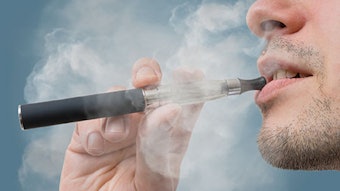Dangers of e-cigarettes
As electronic cigarettes, also known as e-cigarettes, have become popular in recent years, accidental injuries from these devices have increased in frequency as well. These incidents include explosions, burns, and poisonings.
Ofer Jacobowitz, MD, PhD
As electronic cigarettes, also known as e-cigarettes, have become popular in recent years, accidental injuries from these devices have increased in frequency as well. These incidents include explosions, burns, and poisonings.
Explosion and burn injuries
These injuries are due to the lithium batteries, which power the heating element of the device to vaporize the nicotine chemical solution. According to the U.S. Fire Administration’s Report on Electronic Cigarette Fires and Explosions1 the risk and dangers of lithium battery malfunctions in e-cigarettes are greater than those of lithium batteries used in cell phones. This is due to e-cigarettes’ cylindrical case and improper charging via the USB port.
E-cigarette batteries contain a flammable electrolyte solution that is heated to a boil when the battery fails. Pressure builds within the battery until the seal breaks at the weakest point, which is the end of the cylinder. The expanding heated gas in the device can then propel the e-cigarette case and/or battery like a bullet from a gun, causing serious injury. Cell phone batteries, in contrast, are flat and enclosed in a rigid plastic case, thus reducing the risk of projectile injury and usually limiting the incident to a fire.
E-cigarette battery failure most commonly occurs from charging the battery using a non-manufacturer supplied power adapter, or a poorly made adapter, which can expose the device to a dangerously high current. E-cigarette users have also been known to carry a spare battery in a pants pocket that has made the battery more susceptible to malfunction when in contact with other objects in the pocket, such as coins.
As a result of the chemical fires and projectile tissue blasts, an increasing rate of injuries has been seen in trauma centers. In an NBC news report2 on March 6, 2016, Anne Wagner, MD, of the University of Colorado Hospital Burn Center, noted six cases of third-degree burn injuries in a two-month period. Reported injuries include:
- third-degree burns to the face and extremities
- tendon injury
- facial bone and vertebral fractures
- palatal fistula
- loss of vision
To reduce injuries users should:
- store spare batteries in a case
- avoid excess heat exposure
- use only designated power adapter for charging
- stay clear of home-made nicotine delivery products
Poisoning injuries in children
Poisoning injuries of children from ingestion of the “e-juice,” or liquid nicotine solution has also increased in frequency with the greater adoption of the e-cigarette alternative to traditional smoking. E-cigarettes and their refill containers can deliver a high concentration and quantity of readily absorbable nicotine drug. Based on information from the National Poison Data System, accidental nicotine poisoning of children by e-cigarettes increased by 1500 percent from 2012 to 2015. Ingestion of e-cigarettes products by children has led to 5.2 times higher admission rate and 2.6 times the rate of severe reactions as compared with regular cigarettes.3 Poisonings were most common in toddlers.
Although the most common reaction has been vomiting, rare severe reactions also include:
- coma
- seizures
- respiratory and cardiac arrest
- one reported death
E-cigarettes are marketed in colorful packaging, in a plethora of flavors and may appear like candy to children, especially to toddlers. Packages may have pictures of candy or fruit and may come in flavors such as bubblegum and various carbonated beverages or coffee. Liquid nicotine refill containers have been of particular concern as they lack child-proof closure mechanisms.
As a result, the American Academy of Pediatrics along with the AAO-HNS and other organizations responded to an FDA advanced notice of proposed rulemaking in June 2015, requesting extensive child-proofing for liquid nicotine, warning labels, restrictions of quantity and concentration of nicotine in containers, and strict regulation of marketing images and flavors. The Child Nicotine Poisoning Prevention Act of 2015, which requires child-resistant containers for all liquid nicotine products, became public law in January 2016.4 Draft pre-market guidance for nicotine delivery devices5 was posted in May 2016 by the FDA for review and may lead to needed further regulation of e-cigarettes.
References
- https://www.usfa.fema.gov/downloads/pdf/publications/electronic_cigarettes.pdf
- http://www.nbcnews.com/business/consumer/what-s-causing-some-e-cigarette-batteries-explode-n533516
- Kamboj A, Spiller HA, Casavant MJ, Chounthirath T, Smith GA. Pediatric Exposure to E-Cigarettes, Nicotine, and Tobacco Products in the United States. Pediatrics. 2016 Jun;137(6).
- https://www.congress.gov/bill/114th- congress/senate-bill/142. Accessed February 15, 2016
- http://www.fda.gov/downloads/TobaccoProducts/Labeling/RulesRegulationsGuidance/UCM499352.pdf















